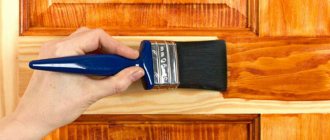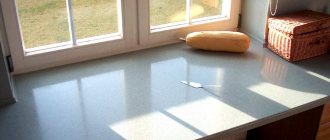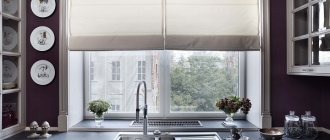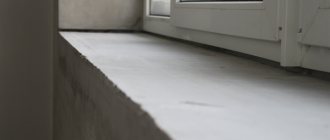Finishing
When installing plastic windows, old wooden window sills are dismantled and replaced with new structures. Standard white surfaces do not suit all users. Recently, cladding with original mosaics and ceramic tiles has become popular.
Classic option for finishing a large surface
Peculiarities
A properly installed window sill will decorate any room. Finishing with universal tiles is a rational solution. This material is not afraid of moisture, resistant to dirt and stress. High-quality cladding increases the strength of the structure. Tile surpasses even plastic in all respects, as it does not fade, is not afraid of contamination, and is easy to clean.
An original option for the kitchen
DIY repair
You can finish the window sill yourself. Some tips:
- It is necessary to check the integrity of the base: there should be no cracks, large scratches, chips, voids or other defects on the surface.
- The best base for tiles is concrete. This finishing material fits well even on wood and plastic.
- The working surface must be well secured in the opening.
- Finishing should begin after installing the window frame and external sill.
Cutting tiles
The fastest way to decorate a window sill with mosaics
If you can’t look at your PVC window sill without sighing, there is an excellent solution - decorating the window sill with mosaics.
The fastest and easiest way to make a spectacular and practical window sill yourself is to glue a glass mosaic on a mesh onto its surface. In this case, the composition can be monochromatic or cast in all the colors of a kaleidoscope. It is good to form a pattern from pieces in colors that harmonize with the color of the walls.
Mosaic on the windowsill: multi-colored decor
Required materials and tools:
- glass mosaic in chips on a grid of different colors
- tile adhesive
- substrate degreasing agent
- self-adhesive tape (wide)
- notched trowel
- grout
- mosaic press
- rubber spatula for grouting
- sponge
- scissors
- STEP 1. Cut the glass mosaic into strips from factory blanks placed on a PVC mesh. Depending on the composition of the pattern, the stripes can be of different lengths.
- STEP 2. Lay the mosaic segments on the windowsill, creating a pattern.
- Step 3. Glue wide self-adhesive tape onto the laid mosaic pieces. Thus, we combine all the elements of the mosaic pattern and remove it entirely from the window sill.
- STEP 4. Next, you need to prepare the substrate: apply tile adhesive to the dust-free and degreased window sill using a notched trowel.
- STEP 5. Very carefully transfer the mosaic composition to the windowsill, lay it flat, pressing it evenly with a special press. Carefully remove the adhesive tape.
- STEP 6. Make an edging using a single mosaic strip. When the adhesive solution has hardened (approximately 24 hours), apply grout in a neutral color or matching the color of the mosaic.
- STEP 7. After the grout has dried, the excess is removed from the surface of the window sill with a sponge moistened with water.
Mosaic on the windowsill: plain decor
The mosaic on the windowsill can also be plain. Then the process of applying it looks a little different.
For this you will need:
- plain glass mosaic in chips on mesh
- glue gun
- liquid nail glue
- rubber spatula
- grout
- White Spirit
- sponge
- wire cutters
- STEP 1. First place sheets of glass mosaic on the windowsill to determine the required dimensions. We cut out the corresponding fragment with pliers, taking into account the edging of the bend.
- STEP 2. Degrease the surface of the PVC window sill using white spirit or another similar substance.
- Step 3. Using a gun, apply a small amount of glue to each segment. Then carefully lay out the mosaic canvas on the windowsill, pressing each square well against the backing.
- STEP 4. After the adhesive layer has completely set (about a day), we begin grouting. The composition is applied using a rubber spatula. Excess is removed with a regular dishwashing sponge.
Practical and aesthetic result - mosaic on the windowsill
Glass mosaic tiles are very smooth, so dirt will not accumulate on the surface of the window sill. Thus, in addition to the fact that it looks beautiful, this decorative window sill is also easy to clean. Accordingly, it can become a harmonious addition to the kitchen or bathroom.
If you are concerned that the mosaic window sill will be “cold” in winter, you can insulate it. To do this, after preparing the base, lay a sheet of extruded polystyrene. Then reinforce with plastic or metal mesh and apply a layer of screed of 50 millimeters. Then begin the standard process of gluing the glass mosaic according to the first or second option.
Restoration of an old window sill with insulation
Restoration of a window sill without replacing it with insulation and glass mosaic covering.
To be honest, we wanted to replace the old window sill after replacing the windows with new ones. However, when the window installers finished their work, it became clear that simply replacing the window sill would not be enough: the window frame turned out to be significantly higher than the level of the window sill. What to do in such a situation? You can replace a thin window sill with a thick kitchen countertop. But we decided to make do with a simpler and more effective solution: we will increase the thickness of the window sill using extruded polystyrene foam (EPS) and cover its surface with glass mosaic. Such a window sill will look stylish, its surface will be resistant to water, sun, high temperatures, and a layer of polystyrene foam will create additional insulation against the cold.
Before gluing the EPS sticker, we washed the window sill and primed its surface with an acrylic primer.
To improve the adhesion of tile adhesive to the smooth surface of the window sill, we attach fiberglass mesh to self-tapping screws.
After this, we glue 3 cm EPS boards, cut to the size of the window sill, onto the old window sill using tile adhesive.
Afterwards, for reliability, we fix the EPS with self-tapping screws to the old window sill.
And prime the EPS with a layer of tile adhesive over the fiberglass mesh.
The base of the new window sill is prepared. We leave it for one day to gain strength.
Then we proceed to gluing the glass mosaic sheets onto white tile adhesive. To distribute the glue, use a 4 mm comb.
We level the glued mosaic on the surface using a foam float.
Now you need to glue small parts of the mosaic to adjoin the shaped surfaces. We bite off the mosaic pieces with ordinary nippers.
And glue them onto the windowsill with tile adhesive.
A day after gluing the mosaic, we begin grouting the seams. Apply the grout with an elastic plastic spatula.
After 15-20 minutes, we begin to wipe the surface of the mosaic with a barely moistened sponge. You have to wipe the surface several times with 15-minute breaks until the surface is completely clean.
This is the new window sill covered with mosaics that we got. Previously, we made a similar window sill in the kitchen at the dacha.
In the same mosaic style we made the wall apron by the balcony door.
Source: dom.dacha-dom.ru
Window sill made of tiles in interior design
Window sills in the bedroom interior
A fashionable and modern solution for finishing work is tiling the window sill with ceramic tiles.
At the same time, its color can effectively harmonize or, conversely, be in contrast with the shade of the countertop.
This will give your kitchen, for example, a unique look that distinguishes it from others.
Peculiarities
A window sill can perform several functions simultaneously. In a small kitchen, this is additional useful space, which is used for arranging indoor plants, cooking, placing dishes and other household appliances.
Finishing using tiles is a practical, stylish and durable solution. Due to its special performance properties, this finishing material is ideal for tiling kitchens and bathrooms.
The material is not afraid of water, resistant to stress and dirt.
Location of tiles on the loggia
Options for placement of tile finishes.
On the floor
Tiling the floor is the best solution for any type of balcony, since this coating has high strength characteristics.
The photo shows the floor on the loggia, lined with multi-colored square tiles.
On the walls
Thanks to the huge range of colors, it is possible to apply various design experiments and create a beautiful, yet universal and functional loggia design.
Threshold
This area can be decorated in the same style as the floor, using residual materials, or using finishes with different colors and textures or mosaics. The main thing is that it is not desirable for the surfaces to be glossy, since they are quite slippery.
Windowsill
A tiled window sill is particularly aesthetically pleasing and functional and fits harmoniously into any interior design for a balcony space.
The photo shows a balcony window sill finished in the form of black clinker tiles.
Slopes
The finishing of slopes has not only a decorative function, but also a practical one. Often there are door or window slopes decorated with mosaic, small metlakh tiles, ceramics, products with imitation artificial stone and other decorations.
Advice from experienced masons
The cladding process will not be difficult if you pay attention to the following factors:
- Surface condition. The base must be complete. If during preparation you find cracks, large scratches, chips, empty spaces, etc., then the problem should be corrected. If you ignore these nuances, the finish will not be of high quality. The tile can simply crack.
- Choosing a base. A concrete base will ensure the durability of the structure and high quality of finishing in general. It will lie on any surface (wooden or plastic) without any problems.
- Surface condition. After checking the area of work, you need to make sure that it is firmly fixed in the opening and will not “ride” during installation.
- Choosing the tile itself. The most important aspect. The type of masonry and the complexity of the work depend on the size of the tile. The diagonal of the tile is selected based on the size of the base. If it is not large, then it is recommended to go with 10x10 or 15x15 tiles. This will eliminate the need for cutting and will give the surface a more attractive appearance. If the dimensions of the base allow you to choose a larger tile, then you can think between 30x30 or 40x20 centimeters. Any store has a wide range of products, so choosing a model is not difficult.
Installation begins only after a new double-glazed window has been installed and the external type of drip has been correctly installed.
Ebbs and visors of plastic windows
A plastic window is not only a double-glazed window and a frame, but also a number of additional elements, without which the window as a whole will not have a finished look and will not last for a long time.
For example, owners of PVC windows cannot do without such special devices as ebbs and canopies that will drain melt and rain water. These structures are installed on the outside of the window in its upper and lower parts, so they are invisible to the eyes of the inhabitants of the house. Ebbs and visors are designed not only to drain precipitation, but also to protect the installation seam under the window. If the seam is not closed in time, moisture will damage it, which can lead to the destruction of the wall and the window falling out. Even if you have an expensive PVC window installed without high-quality drainage, it may soon, in just a couple of years, become unusable.
Ebbs and visors can be made of plastic, tin, galvanized steel and aluminum. Today they are practically not made from tin, since it rusts too quickly, and also looks unsightly, spoils the facade of the building and allows water to pass through. Drains made of galvanized steel do not have these disadvantages, which is why they are now the most popular among consumers.
The color palette of the composition can be very diverse. In addition, such varnish helps to extend the life of the drainage system, as well as preserve its appearance. The ebb or visor covered with this composition will not fade in the sun and will be resistant to temperature changes. Window structures treated with polymer will give the appearance of the entire house a finished look.
After the all-metal sheet is painted, it is cut into pieces and given the required shape.
As you can see in the photo, the shape and size of the ebb and visor of a plastic window can be very different:
They are often made according to customer drawings.
It should be noted that ebb tides and visors are produced by both domestic and foreign manufacturers.
Those produced abroad will cost more, but this does not mean that they have better quality characteristics compared to domestic ones.
Drainage systems manufactured in Russia have a number of important advantages: low cost (and, consequently, low final price) and durability, which is ensured through the use of high-quality steel.
Compared to castings made of aluminum and plastic, steel structures are superior in a number of indicators:
- resistant to UV radiation;
- look aesthetically pleasing;
- resistant to precipitation (rain, snow) and temperature changes;
- resistant to corrosion;
- durable;
- resistant to mechanical damage;
- are inexpensive.
It should be noted that plastic moldings can also be used for installation on the outside of windows.
In addition, plastic elements are durable, do not require special care, do not fade when exposed to sunlight, and also increase the sound and heat insulation of PVC windows.
Visors and sills are easy to manufacture, but they require some work to install correctly.
This design will allow you to use drainage systems for the maximum amount of time.
The next section of the article is devoted to which slopes are best to choose for plastic windows.
What is necessary
To lay ceramics efficiently, you need to prepare the necessary tools and consumables. The standard list includes:
- Universal primer.
- Adhesive solution.
- Tile.
- Grout for seams.
- Pliers.
- Glass cutter.
- Hacksaw.
- Building level.
- Small rubber mallet.
- Standard spatula.
For the window sill in the kitchen, porcelain stoneware is the best choice. This material has high strength.
Basic set of tools
How to choose and what to combine with
The most direct way is to match the material of the window sill with the frame. The frame will look more complete if the window sill is continued in the slopes. It is harmoniously combined with the color of furniture facades and some of the finishing.
Plastic structures are easy to install and do not require special care. It is advisable that the detergent used does not contain abrasives. PVC products are characterized by the ability to imitate wood or the texture of natural stone; you can choose different thickness, size, matte or shiny surface.
Wooden window sills are close to the classics, cozy, and have good thermal insulation properties. They will last longer if they are protected with a special coating and have less contact with moisture.
The top layer of MDF and chipboard is also laminated and covered with cork or “stone”.
In addition to the fact that a granite window sill will not fit plastic frames at all, it should only be purchased with a certificate; it can accumulate radiation. Marble is highly durable and comes in a wide range of color options.
Installation
At the stage of laying tiles, it is necessary to prepare an adhesive composition. The solution is applied to the base and back side of the tile evenly and carefully using a spatula. When laying tiles, ensure the integrity of the pattern. Don't forget about the gaps between the tiles. To place the tiles at the same distance from each other, you can use special crosses that differ in size.
For convenience, it is recommended to arrange a slight slope of the window sill from the window to the outer part of the structure. This will help prevent moisture buildup by allowing water to flow from the base of the frame to the edge. As soon as the laying of the horizontal dies is completed, it is necessary to begin installing the end parts. The placement technique is similar to that described above.
As you work, carefully ensure that the vertical and horizontal elements match each other at the joints.
After the entire window sill is tiled, putty is used. For greater practicality, experts recommend using the composition in dark colors. The most common options:
- beige;
- brown;
- burgundy;
- dark grey.
The choice of shade is selected depending on the color of the tile. Once the solution has completely dried, the window sill is thoroughly cleaned. Now the updated window sill is ready for use.
No. 7. Finishing slopes with metal
Metal slopes are used only for exterior decoration; they began to be used back in Soviet times. This is one of the most successful ways to protect slopes from the outside. Among the main advantages we note:
- resistance to moisture, temperature changes, microorganisms, sunlight;
- metal does not crack like plaster and does not require regular coating renewal;
- metal tolerates low temperatures well, unlike plastic;
- metal with a polymer opening has enormous durability, does not rust, retains its shape and color, and protects windows from blowing;
- the color of the metal can be any, so the finish can be successfully combined with any façade material;
The main disadvantage is only the high cost, but every year you will not have to whitewash, tint the slopes or seal cracks in the plaster. It is best to install such slopes immediately after the installation of the window is completed.
Subtleties of preparing the base
Each time cladding work should begin with this procedure. Carefully remove old enamel, putty, and other coating. You also need to remove all dust and dirt. After this, a deep penetration primer is applied to the surface. Increased attention is paid to the selection of high-quality ceramics.
If the window sill is compact, then the finishing material should be small. Elements measuring 10x10 or 15x15 cm are quite sufficient.
For large window sills it is better to choose larger tiles. In some cases, the choice can be made on elements measuring 40x20 or 30x30 cm.
It is not difficult to choose high-quality finishing ceramics. This material is available in a wide range.
Balcony design
Thanks to a variety of design solutions, the result is a truly unusual and aesthetically beautiful design of the loggia.
The photo shows a spacious loggia with floors and walls tiled to resemble wood.
Finishing with stone looks very impressive and gives the atmosphere a special piquancy, while facing with brick can give the interior a certain carelessness and at the same time picturesqueness. Porcelain tiles or wood-look ceramics are not only distinguished by their exquisite appearance and believable imitation of natural wood texture, but are also very simple and easy to clean.
The photo shows white marble floor tiles in the interior of a modern balcony.
A tiled covering for laminate or parquet most often has a rectangular shape, which makes it possible to create a design that is as similar as possible to these coverings; products in the patchwork style are similar in appearance to a motley patchwork multi-colored blanket; with the help of this design it is possible to fill the space with a riot of colors and endow it with a positive energy. With the use of mosaics, you can add a stylish twist to the interior of the loggia and give it an expensive look.
The photo shows a small glazed balcony with patchwork floor tiles.
Masonry technology
There are two options: along the entire window and perpendicularly. The choice should be based on minimizing the resulting trimming of parts. To adjust the die, you can use a classic glass cutter.
The location of the cut should be marked in advance using a marker. The trim is placed on a flat and stable base in order to trim along the marked points. During the procedure you need to press hard on the material.
It is difficult to achieve a high-quality result without a rubber hammer. Using this tool, carefully tap the ceramic product on the back side at the site of the intended cut. If such a hammer is not at hand, then you can use the handle of a spatula, which is first wrapped in a towel or thick cloth.
The required fragment is broken off with a sharp, confident movement. If the master has the necessary skill, then cutting the ceramics can be done with a grinder. This electric tool saves a lot of effort and time.
Rational approach
Ceramic tile cladding
Ceramics are used in rooms with high humidity: in the kitchen, bathroom, shower. To correctly calculate how much material is needed for covering a window sill, you need to measure its surface, compare it with the dimensions of the tiles and add 20% for possible defects.
You can do it yourself by tiling the window sill, if you follow some nuances. The material must be laid at a slight slope so that the water that falls on the windowsill does not flow into the corner, but goes to the floor.
For window sills protruding beyond the wall, you first need to make a concrete base and reinforce it with steel mesh or rods with a diameter of at least 4 mm. Before laying the tiles, check the tightness of the joint where the window sill meets the window. Existing cracks must be treated with silicone putty intended for wet rooms. Ordinary mastic will not work here, as due to high humidity it will quickly begin to crumble.
For cladding, you can use not only white tiles. It is necessary to take into account the design of the room; in some cases, color will look more advantageous. Some homeowners turn a tile window sill into a real work of art, but it’s difficult to do it yourself; it’s better to turn to professionals. It is worth considering that such work will cost more than standard cladding.
In general, the price of a tile window sill directly depends on the quality of the material, the manufacturer and the cost of repair work.
Scope of application
Most often, a tile window sill is made in houses made of brick, ceramic concrete, foam concrete or cinder blocks. In these houses, the window sill, as a rule, has already been filled or a kind of blank has been made that will serve as its base. It must be thoroughly cleaned of dust and primed to increase the adhesion of the material to the base. If this is not done, the tiles may fly off within a few months.
If there is already a window sill, but you need to make a new cladding, you must first remove the old one. Next, the surface of the window sill is carefully leveled, all dents and chips are filled with putty. In order for the tiles to last for many years, you need to purchase putty, primer and glue from one manufacturer in stores.
Mosaic on the windowsill: plain decor
The mosaic on the windowsill can also be plain. Then the process of applying it looks a little different.
For this you will need:
- plain glass mosaic in chips on mesh
- glue gun
- liquid nail glue
- rubber spatula
- grout
- White Spirit
- sponge
- wire cutters
STEP 1. First place sheets of glass mosaic on the windowsill to determine the required dimensions. We cut out the corresponding fragment with pliers, taking into account the edging of the bend.
STEP 2. Degrease the surface of the PVC window sill using white spirit or another similar substance.
Step 3. Using a gun, apply a small amount of glue to each segment. Then carefully lay out the mosaic canvas on the windowsill, pressing each square well against the backing.
STEP 4. After the adhesive layer has completely set (about a day), we begin grouting. The composition is applied using a rubber spatula. Excess is removed with a regular dishwashing sponge.
How to tile a wooden window sill
In order to lay tiles on the windowsill you will need: cementless acrylic adhesive, liquid nails adhesive or polyurethane sealant, as well as cement-based tile adhesive.
- Remove household dirt from the windowsill.
- Apply a thin layer of cement-based adhesive into which the paint mesh is pressed to create a strong base suitable for laying tiles.
- The surface is leveled and dried.
- Working with tiles and laying them out. Based on its size, it is worth determining how it will be located on the windowsill - perpendicular or along the window. Trimming tiles is done using a glass cutter or grinder. First you need to select the cutting location and use a marker to make the necessary marks. Then it is placed on a flat surface and, with firm pressure on the tool, its incision is made. You need to break it off with a gentle blow on a flat corner. If you use an angle grinder, the work will take much less time.
- As soon as it is laid out, it is necessary to remove dirt from its surface and wait until it is completely dry.
- Then, between the laid tiles, it is worth placing the grout of the desired shade. After working with it, its undried residues are removed from the surface. As soon as the grout has dried, the renewed window sill should be thoroughly washed.
It is recommended to seal the seams between the tiles with sanitary silicone. If the gap between the wooden window sill and the open window sash is large, then it is better to attach drywall to the base with self-tapping screws.
Then the plasterboard sheet is primed, dried and tiles are laid on it.
Window sill finishing options
In addition to the standard option for finishing the area near the window, there are several popular options.
Mosaic cladding
Ceramic material can neatly fill a small space near the window. Moreover, outwardly it will look stylish.
If a white mosaic matches the interior, then only white glue should be chosen. Otherwise, the color at the end of the procedure will not be in harmony.
The installation process will be much simpler than with standard tiles and much faster. The finishing material is perfect for any interior design, from classic style to postmodern.
The only significant drawback is the presence of many seams that divide the overall picture. After a certain period of time, without proper care, mold may begin to form in them. Dirt and dust also accumulate in the seams. It is enough to use a high-quality cleaning product at regular intervals.
You can use not just the classic method of laying mosaics; to achieve symmetry, it is recommended to mount the mosaic on a pre-installed grid.
Based on your needs, the dimensions of the entire structure are easily adjustable. Before installation begins, the working surface is checked for cracks and chips. If they are not there, then the tiling process will not differ from working with tiles.
Upon completion of installation, the work area is cleaned. The procedure for insulating the window sill is carried out before installation.
Working with plastic and wood bases
Cladding a wooden window sill is practically no different from working with a concrete surface. It is enough just to properly flash the tree and the entire structure as a whole with a sheet of drywall; after flashing, the procedure can begin.
There is a method in which you do not need to cover it with plasterboard. You will need to treat the wooden surface with an acrylic type primer. Next, epoxy type glue with the same grout is used.
Working with a plastic base is easier. It is recommended to replace the glue with liquid nails. The more textured the plastic, the higher the quality of grip.
When purchasing, it is better to select a composition that is originally designed to work with plastic or wood.
Afterwards the design will be ready for use.
Do-it-yourself window slopes and window sill
How to make slopes and a window sill from plasterboard with your own hands, photographs of the step-by-step production and finishing of the slopes and window sill with ceramic tiles.
Many homeowners, when replacing a window, come to the idea of how to finish the window slopes, and not everyone is happy with the prospect of installing a white plastic window sill.
An alternative to plastic is a window sill frame made of a metal profile, followed by plasterboard covering of the frame and window slopes, after which ceramic tiles are laid on a plasterboard base.
The strength of such a window sill is not inferior to a plastic one, and the possibility of finishing the slopes and window sill with tiles of any shade and texture will allow you to create a beautiful and unique window in your home.
Someone will say that such slopes are cold, and a slope made from a sandwich panel is much warmer, but this is not so.
A gypsum slope is attached with a gap from the stone opening, and the free space is filled with polyurethane foam; the foam creates a barrier to cold, so the inside of the slopes is protected from freezing.
The main advantages of tiles: they are not afraid of moisture, do not get dirty and are easy to clean.
Advantages and disadvantages
There are many options for successfully transforming window sills into stylish and comfortable interior elements. Such designs give their owners a number of obvious advantages, as they allow:
- save usable space and rationally use available space;
- implement interesting projects in any room;
- correct the poor shape of the room;
- create an original interior element;
- save on buying ready-made furniture;
- realize creative ideas;
- make designs with your own hands according to personal needs.
The disadvantages of implementing such ideas are that:
- there is cold coming from the window - in winter it is better not to sit on the windowsill;
- excessive lighting results - additional sun curtains may be required;
- batteries are placed under the windowsill - during the heating season your feet may be hot;
- If you cover the radiators with countertops and cabinets, air exchange is disrupted - it is difficult for heated air to circulate due to the obstacle that has appeared. A way out of this situation can be grilles built into the countertops and furniture doors. Moving the radiators to another wall and installing a heated floor will help correct the situation.
How to make a window sill from tiles or mosaics
As a rule, during renovation, the replacement of old windows with modern metal-plastic ones is accompanied by the installation of plastic window sills and a similar external sill.
If plastic as a material for windows has firmly and permanently come into use, then when installing a window sill, you can, if desired, abandon it and replace it with another material.
In this article we will talk about the advantages of decorating a window sill with ceramic tiles and mosaics and describe the main stages of laying tiles on a window sill.
What to make a window sill from?
The window sill in our apartments and houses can become an active, functional space if we approach the issue of covering it correctly.
This is especially true for window sills in the kitchen - in addition to banal flower pots, you can place pots, pans, and other utensils on them.
The latest fashion trend has been the creation of a tabletop on the windowsill, which is a fairly rational and convenient solution in small spaces.
Of course, a plastic window sill does not shine with the wealth of possibilities that are inherent in this small but very important element of any house or apartment. Over time, the plastic turns yellow from moisture and flower pots, spoiling the aesthetic appearance of the room. It can be damaged due to high loads or excess heat or cold.
In this case, it is better to consider the available alternatives. The simplest options are to paint or sand it, but from an aesthetic and functional point of view, the best option would be a tile or mosaic window sill.
How to make a window sill from tiles with your own hands
Before you begin tiling the window sill, you need to take into account several important factors: - The base of the window sill must be concrete (you can also lay tiles on wooden and plastic window sills. This is discussed further); — The base should not have significant damage (cracks and chips) and be firmly fixed in the window opening;
— All work on installing the window and external sill must be completed.
Preparation for covering the window sill. Tool.
In general, the set of tools and materials is no different from the standard set for laying tiles on the floor:
- ceramic tiles; - primer; - glue; - tile grout; - spatula; - glass cutter; - rubber hammer (optional); - level;
- pliers and hacksaw.
If you are decorating a window sill in the kitchen, then you should consider porcelain stoneware as a facing material. It is stronger than standard tiles and just as easy to maintain. A porcelain stoneware window sill will serve you for a long time, perfectly withstanding hot pans and pots.
At the initial stage, it is necessary to properly prepare the basic foundation for facing work. Remove old paint and putty from the windowsill and clean the surface from dust and dirt. Next, coat the base with a deep penetration primer.
You need to be very careful when choosing tiles. Much depends on the size of the base. If it is small, then it is better that the tiles for the window sill are small in size - 10x10, 15x15.
This will avoid unnecessary hassle with trimming and will significantly improve the aesthetic appearance of the product. If the base is quite voluminous, then you can choose larger ceramics - 30x30, 40x20, etc. Especially if the room is small and every meter of space is precious.
For example, a wide window sill in the kitchen can be turned into a comfortable countertop.
Technology of window sill cladding with ceramic tiles.
Depending on the size of the tile, you should determine in advance how it will be placed on the window sill - along the window or perpendicularly. You need to find the best option in which the need for pruning will be minimal.
The cutting itself is done using a glass cutter. First, you need to decide where to cut the tiles and use a marker on the front side of the material to make the appropriate marks.
Next, the tile is placed on a flat surface and a glass cutter is made along the intended marks by pressing firmly and firmly on the tool, so that the cut is thorough.
Then, on the back side of the tile (in the place where it is supposed to be cut off), you need to tap it with a rubber hammer or the handle of a spatula (for greater confidence, you can wrap the handle with a thin towel). We will break off the tiles with sharp, gentle blows on an even corner. In this way, horizontal and vertical samples are made for laying on the windowsill.
Instead of a glass cutter, cutting tiles can be done using a grinder. For experienced craftsmen, this helps save more time, but requires skill in working with the tool and accuracy.
The next step is laying the tiles on the windowsill. To do this, you need to prepare an adhesive solution and apply it in even layers on the back side of the tile using a spatula. When laying tiles on the surface, observe the gaps between the tiles.
Tip: it is better if you use a building level to fix a slight slope from the window to the outer part of the window sill so that water or condensation does not accumulate at the base of the frame.
After finishing laying the horizontal tile elements on the window sill, you can begin installing the end parts. Here everything is done using a similar method. Make sure that the horizontal and vertical (end) elements match each other at the edges.
When the entire area of the window sill is tiled, you need to clean the surface from any remaining mortar and wait for it to dry completely. Next, grout of the desired color is laid in the gaps between the tiles.
The main advantages of clinker window sills
High strength is a distinctive feature of clinker. The thing is that this is not ordinary ceramics: the clay mass is sintered at a very high temperature (from 12,000 C and above). The result is a material that can withstand heavy loads, resistant to impacts, scratches, and other mechanical damage.- Excellent aesthetic characteristics. Dozens of color shades, textures and shapes of clinker elements allow you to create a window sill that will organically “fit” into the appearance of the house.
- Resistance to various weather tests. Rain, snowfall, hail the size of an ostrich egg - the clinker window sill itself will remain intact, and will even protect the facade. The material can withstand up to 300 cycles of freezing and thawing - an indispensable quality for our climate, where the thermometer can cross zero up to 10 times a day.
- The color of the window sill remains pristine, even under the burning sun. The secret of such “constancy” is that the clinker is colored “in bulk”, that is, throughout the entire structure during the manufacturing process.
- Eco-friendly material. Each tile is based on natural slate clay, thoroughly cleaned of impurities. Therefore, the finished products are absolutely safe for health and do not cause allergies.
- Record service life. Such ebb tides last for at least half a century (official manufacturer’s warranty). But for clinker, 100 years is not the limit, and over time the coating takes on an even more noble vintage look.
- Easy to clean: just wipe the tides with a damp sponge when they get dirty. You can use chemical cleaning agents - the surface and structure of the clinker will not deteriorate.
Which window sill to choose: main varieties
It would seem that a traditional element is a window sill, what variety there can be. Leading manufacturers of clinker facing elements will object: there are dozens of all kinds of ebb models. Each collection is unique. To decide which window sill to choose, you need to imagine the general style of the house and the size of the window openings.
Traditional installation method
Before you begin installing ceramics, you need to prepare high-quality glue. The solution is applied with gentle movements to the back side of the finish and the work surface. You can use a spatula to distribute the composition. During installation, you need to ensure that the elements of the pattern match.
There must be a gap between the dies. To ensure that all the parts lie at the same distance from each other, special plastic crosses are used, which also differ in size.
Experts recommend forming a slight slope of the structure from the window to the outside. Thanks to this, it will be possible to avoid the accumulation of condensation, since all the water will flow from the base of the frame to the very edge. The end parts are mounted only after the laying of the horizontal dies is completed. Once all the tiles have been laid, you can proceed to using putty. It is more practical to use a dark shade. Popular options:
- Blue.
- Beige.
- Brown.
- Burgundy.
The choice of putty shade depends on the color of the tile. Once the solution has completely hardened, the window sill is thoroughly cleaned. After this, the updated surface is completely ready for use.
Attention! During work, you need to ensure that all vertical and horizontal elements are as consistent as possible with each other at the joints.
Interesting shades of grout
Decoration with mosaic tiles
Recently, tiling the window sill with mosaic tiles has become popular. The process of laying mosaics is much simpler and does not take much time. This design looks modern and stylish.
The only disadvantage of this cladding is that it has a lot of seams, because the mosaic is much smaller than ordinary ceramic tiles. Moisture can accumulate in the seams and mold can appear, making it difficult to care for the surface. The problem can be avoided if you purchase high-quality grout for joints; you should not skimp on this. When choosing a mosaic for cladding, you need to understand in advance that you need to take more care of such a window sill.
As a decoration, you can purchase a ready-made mosaic in the store or make it yourself from broken tiles. The second option will require certain skills in working with glass. If you do not have such experience, then it is better not to experiment so as not to get injured.
Before laying the mosaic, the surface of the window sill is prepared in the same way as for ceramic tiles. Then special glue is applied to it and mosaic elements are laid. Excess pieces of material are cut off with a glass cutter. Excess grout is removed with a rubber spatula. After the surface is completely dry, clean it with a damp sponge.
Selecting masonry type
In most cases, the master has to choose from two options:
- Along the area around the window.
- Perpendicular to it.
The dimensions of the base should be taken as the basis for choosing the type. It is necessary to minimize unnecessary trimming of materials. To adjust the die to the dimensions, use a regular type of glass cutter.
After determining the location of the incision, the area is marked with markers. Cladding should only be carried out on a smooth surface that is firmly fixed. Otherwise, you will not be able to trim the marked marks.
You should not be afraid to press hard on the laid material. If you press weakly, then there is a chance that the tile will not press through.
To do the job carefully, a rubber hammer will help, which should be used to slowly tap ceramic products in places where there is a potential cut. As an alternative to a hammer, you can use the handle of a spatula. But you should wrap it in something soft (for example, a towel) in advance, otherwise there is a risk of damaging the product.
The selected part must be broken off with a sharp and forceful movement. If you are not sure that the process will be like this, it is recommended to use an angle grinder. It will save time and physical effort.
Why do tiles fall off?
Tiles can fall off for two reasons.
The first is that you are using tile adhesive that is too liquid; it absorbs and dries quickly, causing adhesion to deteriorate and adhesion to decrease. In modern adhesive tile mortars this is unlikely, since they contain various additives and fibers that prevent this.
The second reason for tiles falling off most often is that the master does not apply a contact layer to the base of the window sill or does not apply tile adhesive to the tile itself - in both cases, the quality of adhesion suffers irreversibly and this cannot be done because adhesion is reduced significantly and the tile sooner or later it will fall behind.
If your window sill is made at an angle, the corner tiles must be cut with a tile cutter into a wedge-shaped shape. Since after this its area will decrease, such a tile will be a weak link, so pay especially close attention to laying such a tile and grouting its seams.
The outer tiles of the window sill must be deepened into the wall and window slope as much as possible, so that water does not accumulate at the joints and does not run along the facade, leaving behind streaks.
Important nuances
The finish will look beautiful if you think it through well in advance. Create the pattern you want to see and decide what size tile will work best for you. Almost always, the best solution is to decorate the window sill with small details or mosaic tiles. They will require minimal styling skills from you and will make the whole process much easier.
Remember that the water resistance of the coating will not be complete if you choose the wrong grout. It must also have the necessary properties. Even in rooms where the humidity is within normal limits. Window openings are more susceptible to moisture, since this is where the border between the cold air from the street and the warm air inside the house is located. Condensation can easily appear. Otherwise, everything will not be so difficult to do. The design of this surface will not differ much from the laying of standard tiles.
Balcony color scheme
Due to a well-chosen shade, which should be used taking into account the comfortable stay in the room, it is possible not only to create a beautiful design, but also to radically change the geometry of the space.
For example, white color imparts lightness to the atmosphere and significantly increases the area of the loggia, aristocratic gray shades can simultaneously look modest, sophisticated, elegant and very original, the brown range is particularly natural, and green and yellow tones undoubtedly bring extraordinary freshness, naturalness and brightness to the atmosphere .
The photo shows a panoramic closed balcony with a floor decorated with gray tiles.
For small balconies, the traditional solution is light colors that visually expand the space and their pastel shades.
The photo shows partial finishing of the walls and parapet using brown brick-like tiles on the loggia.
Sheathing base made of wood and plastic
The process of finishing window sills from natural materials is no different from finishing concrete surfaces. But in this case, the craftsman will have to cover the entire structure with plasterboard slabs in order to then lay the colored tiles. You can do without cladding gypsum board, but in such a situation you should use an acrylic primer, which is used to cover wooden window sills. For installation you will need epoxy glue and grout.
It is much easier to decorate plastic bases. Instead of an adhesive solution, you can use liquid nails. The reliability of adhesion directly depends on the texture of the plastic. Specialists use special compounds for laying ceramic products on plastic or wooden bases.
Sources
- https://mezhdveri.ru/28711-obustrojstvo-originalnogo-i-dolgovechnogo-podokonnika-iz-keramicheskoj-plitki.html
- https://beton-monolit.ru/podokonniki/podokonnik-iz-kafelnoj-plitki.html
- https://SerebKlych-uk.ru/otdelka-i-remont/podokonnik-iz-plitki-keramicheskoj-2.html
- https://okna-dom.net/otdelka-podokonnika-plitkoy/
- https://stroy-podskazka.ru/furnitura/podokonniki/iz-plitki/
- https://florantino.ru/podokonniki-iz-plitki-foto.html
- https://esto-okna.ru/balkony-i-lodzhii/otdelka-podokonnika-plitkoj.html
- https://krovli-zabori.ru/podokonniki/podokonnik-iz-plitki-svoimi-rukami.html
- https://zh-art.ru/krasivye-podokonniki-iz-plitki/
- https://proosteklenie.com/podokonnik-iz-kafelnoy-plitki/
- https://promalpworks.ru/podokonniki/podokonnik-iz-plitki-svoimi-rukami.html
- https://mailtrain.ru/podokonniki/podokonnik-iz-kafelnoj-plitki.html
- https://vesnakuhni.ru/podokonniki/podokonnik-iz-kafelnoj-plitki.html
- https://dom-kirov.ru/balkony/podokonnik-iz-plitki.html











